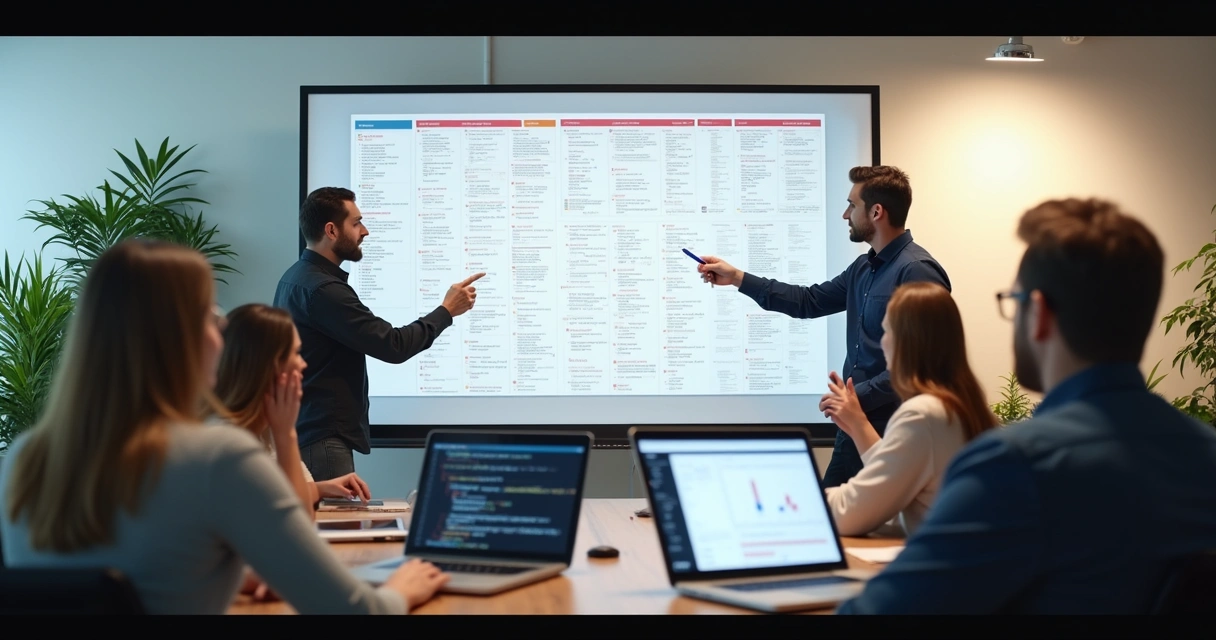What does it actually take to turn an early idea into something real? Not just another pitch deck, but a digital product users can see, click, and react to right now? In the world of startups and innovation, the answer usually points to a well-built MVP. But what goes into custom MVP creation, step by step—for you, your unique market, your real users? In this complete guide, we’ll walk through how custom MVP development services make the leap from a first conversation all the way to a launched, living prototype, with all the pivots, tech choices, and feedback loops along the way.
You’ll find actionable details and specific stories, not just the same old theory. Whether you’re an ambitious founder, a new division leader at an established company, or someone figuring out if your solution really solves a problem—this guide will help you understand the process, risks, and practical choices that make the difference. DeMeloApps, a Vancouver-based software studio, works daily with projects exactly like these, so we’ll include the perspective of teams shaping ideas into powerful, investor-ready MVPs.
What is a custom MVP and why does it matter?
Let’s clarify the basics, because it’s easy to get tangled up in buzzwords.
Build just enough. Show real value. Learn fast.
An MVP—minimum viable product—is the simplest version of your product that solves your users' main problem. It gives enough for actual people to use and react to, without adding all the extras you might one day dream of. A custom MVP is shaped specifically for your unique business—built for your concept, your customers, your industry. It's about what fits your path, not just some generic toolkit.
Why do startups, founders, and even large organizations now see custom MVPs as a core growth strategy? Here are a few reasons:
- Risk reduction: Testing big ideas with a small, working prototype spots issues early, before big budgets are spent.
- Market validation: Real user feedback shows if the problem you address actually matters—and if users will pay for your solution.
- Faster funding: Investors often fund products, not just plans. A working MVP attracts more serious conversations, just as we’ve seen at DeMeloApps.
- Focus and momentum: By slicing away nice-to-haves, your team works on what matters most.
- Scalability from the start: A good custom MVP doesn’t trap you; it leaves the door open to grow, update, and expand.
This guide walks you through the entire cycle—each step, each pivot, with stories and practical advice mixed in.
Stage one: discovery that listens first
Most MVP journeys begin with, frankly, a lot of uncertainty. You might know your market well, or maybe you just think you do. Here, discovery should not be a box-ticking exercise. A great team will start by listening—really listening—to your vision and the environment your idea lives in.
- What problem are we truly solving?
- Who feels this pain most sharply? Can we find them?
- What broke in previous solutions? Why hasn’t this been solved?
- What’s your wildest hope for this product?
This stage is messy, sometimes emotionally charged. There’s excitement for what could be, but fear of spending weeks on features users don't need. At DeMeloApps, we often see founders are surprised by what users really want, not just what they think should be built.
Teams conduct interviews, brainstorm paper models, and create user stories. It’s basic—but these activities narrow the scope, helping you craft sharp, testable hypotheses for what to build first.
 The outcome of discovery? A clear statement: Here’s what we’re building, for whom, and why now.
The outcome of discovery? A clear statement: Here’s what we’re building, for whom, and why now.
Stage two: rapid prototyping
Once everyone is in sync on core assumptions, prototyping puts ideas into action—quickly. This is not pixel-perfect design; it’s rough, it’s unfinished, and that’s the point.
Ideas become visible, testable, stealable—and that’s a good thing.
Founders, designers, and sometimes potential users will try clickable wireframes, simple demo flows, or basic user journeys. These prototypes are low-cost but high-value. They reveal friction long before any code.
- What steps confuse users?
- Can people complete their goals easily?
- Are we missing something obvious?
Prototypes are often iterated multiple times before coding even begins. One startup DeMeloApps consulted pivoted twice during this stage. The result? The MVP focused tightly on what users actually did, not on what was originally planned.
Stage three: choosing the technology stack
Picking the right technologies isn’t glamorous, but it’s a decision that shapes what you can (and can’t) do—today and two years down the line. Does your MVP need to be mobile? Web first? Or cross-platform? And is cost a factor, or are you ready to invest for rapid future growth?
A careful tech choice means:
- Your MVP is reliable, even with limited features.
- Scale doesn’t break the budget—or force a rewrite down the road.
- The developer pool is good, so you’re not tied to a rare, expensive skillset.
DeMeloApps, for example, often recommends stacks based on proven performance for startups, like React or Flutter for mobile MVPs. But the industry matters—healthcare MVPs may need to focus on secure frameworks, while a SaaS MVP might favor speed and low hosting costs.
 These are choices best made with honest conversations about future goals and current limits.
These are choices best made with honest conversations about future goals and current limits.
Stage four: design that fits real users
Design makes the difference between something people can use and something they want to use. But design isn’t just about pretty interfaces; it’s about workflows, clarity, and even trust.
- Are users greeted with clear instructions, or do they have to guess?
- Does the design suit the target audience? (For example, a financial app for retirees should not look playful.)
- Is every action obvious and accessible?
The first designs are rarely perfect. It’s common for DeMeloApps clients to toss out an entire set of screens after a single feedback session. That’s not wasted work—it’s “cheap” learning.
Teams craft clickable prototypes, logo concepts, and color schemes. These get tested with end users or stakeholders, gathering honest (sometimes painful) reactions before the first line of app code is written.
Stage five: development with agility
“Agile” is a word that gets used a lot, perhaps too much. So what does it really mean for a startup building their MVP?
Build. Test. Listen. Refine. Repeat.
Agile development is about short cycles, continuous feedback, and real flexibility. According to a study of over 1,000 projects, agile methods improved both efficiency and stakeholder satisfaction, and hybrid approaches (mixing agile with classic planning) were common in getting things over the finish line.
The heart of agile MVP building means your team works in sprints. At the end of each sprint (maybe two weeks), there’s something usable—even if it's basic. You can show it to investors, demo it to users, invite skepticism, and gather feedback on what's next. Changes are expected. Learning is valued.
DeMeloApps applies agile cycles in all custom MVP builds, shifting priorities as new discoveries arise. This way, unexpected user needs or technical limitations can be addressed quickly, before the project goes off course.
 Several studies, including those reported by the U.S. Government Accountability Office, found that agile software development decreases risk and shortens delivery timelines. Still, there’s nuance: a 2022 study found that agile increased productivity for some teams, but not all. Experience and culture matter—a lot.
Several studies, including those reported by the U.S. Government Accountability Office, found that agile software development decreases risk and shortens delivery timelines. Still, there’s nuance: a 2022 study found that agile increased productivity for some teams, but not all. Experience and culture matter—a lot.
Stage six: testing with actual users
Now, the MVP works. But will users use it? Expert QA (quality assurance) and user testing with a real audience often show surprises. Buttons in the “wrong” place. Feature wording that confuses. Flows that don’t fit how real people act.
User testing ranges from internal dogfooding to remote testers, all the way to small focus groups. Sometimes, features you debated for weeks don’t even get noticed. Sometimes, a tiny bug could kill user trust if it’s missed.
- Does the sign-up process finish smoothly?
- Can users find what they need, fast?
- Are there points of friction, hesitation, or drop-off?
Experienced MVP developers, like those at DeMeloApps, treat bug fixing and user feedback as ongoing—never just a check mark near “done”.
Stage seven: feedback-driven iteration
Here’s the uncomfortable truth—your first version won’t be right. Maybe not even your second. Industry data today, after analyzing project success rates for decades, shows software project success stabilizes around 46% (across 30 years of surveys). The biggest factors? Adjusting quickly to feedback, testing often, and avoiding “gold-plating” features that don’t matter.
Your MVP should evolve with feedback, not fight against it.
Feedback comes from many places: user data, bug reports, investor reactions, even just gut instinct from someone on the front lines. The development team reviews this feedback every sprint, making honest calls about what to keep, change, or remove.
It’s common to:
- Shrink, merge, or cut features that aren’t used.
- Move key functions to a more visible spot.
- Tweak onboarding to reduce confusion.
Iteration is not a sign of failure. It’s evidence you’re learning.
Stage eight: launch with intention
“Going live” means more than uploading to an app store. It’s a deliberate process—small, targeted launches are often smarter than a “big bang” rollout.
- Soft launch to a select user group, measuring reactions closely.
- Create clear channels for bug reporting or user feedback.
- Monitor usage, engagement, and drop-off in real time.
- Have a developer on standby to quickly patch any critical issues.
Launching well can make the difference between an MVP that fizzles out and one that sparks a movement. As teams at DeMeloApps have seen, launch isn’t just a line in the sand—it’s the first leg of a much longer journey.
 Stage nine: post-launch support and growth
Stage nine: post-launch support and growth
After launch, things get real. You’ll learn what you didn’t even know you needed to know. Users behave in unexpected ways. Systems may face real-world loads for the first time. This stage is about quick reactions and thoughtful planning.
- Rapid bug fixes—especially for anything affecting onboarding or payment flows.
- Early infrastructure tweaks if growth outpaces your forecasts.
- Direct engagement with early user groups (think: personal emails, quick surveys, interviews).
- Planning next steps—what minor features will give the most new value now?
Skilled teams keep analytics dashboards and error trackers running day and night. Sometimes, there’s even a surprise—the “wrong” users adopt your MVP in unexpected ways. This feedback sparks the next cycle of learning, investment, and feature updates.
Agile as a mindset, not just a method
Throughout these stages, agile development shapes every decision. But agile isn’t just a process—it’s about team culture, communication, and comfort with change. According to satisfaction studies, agile outperformed older methods for supplier satisfaction, but the biggest benefits came from keeping teams flexible and close to end users.
- Stand-ups and weekly reviews keep everyone synced—even when working remotely.
- Short iterations limit wasted effort on features that don’t matter.
- Flexibility means you can adapt to new funding, user discoveries, or regulatory changes.
It’s worth noting that not every team adapts to agile instantly—it takes time and honest feedback from everyone involved.
Why industry knowledge matters so much
Custom MVPs are never truly generic. Different industries have different needs, standards, and user behaviors. Here’s how MVP building changes based on sector:
- Fintech: Security, compliance, and trust come first. MVPs might need to sandbox fake data but must appear credible. Your MVP can’t gloss over data privacy.
- Education: Users include teachers, students, and admins—each with different expectations. Clear onboarding and accessibility could make or break adoption.
- Health tech: HIPAA or other regulations shape MVP scope early. Easy integration with third-party services (EHRs, appointment platforms) may be non-negotiable.
- SaaS platforms: Self-service trials, clear value propositions, and scalable backends must work from day one. Integration with payment or analytics as part of the MVP.
DeMeloApps has built for all of these environments, tailoring each MVP to fit compliance, design, and scale needs right from inception.
 Understanding your sector isn’t just “nice to have”—it changes everything about how your MVP should work.
Understanding your sector isn’t just “nice to have”—it changes everything about how your MVP should work.
How engagement and pricing works in MVP projects
Engagement models for custom MVP creation often differ depending on your team size, funding level, and internal expertise. The most common models include:
- Fixed-price MVP packages: Best suited when the scope is narrow and well-defined. You get a clear statement of work, predictable costs, and fast delivery. Ideal if you’re aiming for a demo or proof-of-concept.
- Time and materials: Flexible for when scope is uncertain or changing. Pay for hours worked or resources consumed. Good for evolving MVPs with shifting requirements.
- Hybrid or milestone payments: Set fixed prices for core phases (e.g., discovery, prototyping) with hourly work for later changes. This balances predictability and agility.
Most MVPs—even small ones—need to budget for discovery, design, development, user testing, sprint review, and post-launch support. The question of cost comes up a lot: for example, DeMeloApps offers clear MVP starter packages as well as builder options for more complex projects.
But pricing can vary widely. Factors include:
- Number of features—less is often more.
- Custom integrations or third-party dependencies.
- Industry-specific compliance needs (especially for health, finance).
- Level of polish and post-launch support.
The key: work with a provider who gives you honest estimates up front and keeps you informed during every step. For a personalized assessment, many teams use a project quotation platform to get a sense of likely cost and timeline.
Validation, scalability, and funding impact
The true goal of a well-crafted MVP isn’t just getting to “done”—it’s proving your solution works, attracting users, and unlocking the next round of funding. Validation isn’t about nice charts or vanity metrics; it’s about real users and measurable traction.
- Can you show user signups, usage, or revenue?
- Do you know which features drive key engagement?
- Are there real testimonials or early-adopter case studies?
When done right, an MVP allows your team to move fast without breaking everything. The best MVPs are designed for scalability too, so successful outcomes don't require rebuilding from scratch.
Investors, accelerators, and even enterprise clients judge your readiness based on what you’ve proven, not just what you’ve planned. Working with experienced MVP builders, like those at DeMeloApps, shortens your path to readiness and makes your product story far more persuasive.
Navigating the process with the right team
Building a custom MVP requires a rare blend of technical skill, user empathy, business sense, and emotional resilience. Mistakes happen. Features also get dropped, sometimes painfully late. The process isn’t easy but, with the right partner, it is manageable.
Here are a few things to look for in a development team:
- Clear portfolio of real MVPs (you can review some at the DeMeloApps company story).
- Experience in your sector, with evidence of adapting to industry needs.
- Honest communication about risks and changing requirements.
- Structured, transparent process—with regular updates, demos, and direct access to developers.
Close collaboration—not just outsourcing—leads to the strongest MVP results.
 Getting started: from idea to action
Getting started: from idea to action
If you’re ready to test your idea, get user traction, and move toward funding, starting your MVP journey is far easier with a clear guide and experts by your side. Teams at DeMeloApps have enabled founders, educators, and enterprise innovators to turn sketchpad concepts into products that attract funding and survive the tough first year in the market.
For anyone exploring whether now is the time to build, tools like the MVP platform and the step-by-step MVP builder can help you scope, estimate, and prepare for your custom project with transparency.
Sooner or later, every founder faces the same moment—the leap from “what if?” to “what next?”. Don’t let uncertainty be the reason your idea stays on the sidelines. Custom MVP development is the structured, flexible path from raw idea to reality.
Conclusion
Custom MVP development is as much about listening and learning as it is about building. When done well—with real collaborations (not just tech), agile methods, and a step-by-step process—you move from a risky hunch to a product that users and investors can believe in. The journey isn’t simple, but it is worth it. Whether you represent a startup, an educational institution, or an established business, teaming up with experienced developers dramatically increases your odds of launching something real and fundable.
Now’s the time to take the next step. If you’re thinking bigger and want to see what’s possible for your idea, schedule a free consultation, or get your project’s first estimate. The DeMeloApps team is ready to help your vision become reality—one careful step at a time.
Frequently asked questions about custom MVP development
What is custom MVP development?
Custom MVP (Minimum Viable Product) development refers to building the simplest version of a new product, designed around the unique needs and goals of a particular business or concept. Unlike off-the-shelf solutions, this process tailors both function and design for a specific market or problem. You get a working prototype—something users can try, test, and provide feedback on—instead of just static plans. The custom part means it matches the exact requirements and branding of your startup, company, or institution. This helps verify your core idea and makes future growth much easier.
How much does MVP development cost?
Prices for MVP development can vary quite a bit, mainly due to factors like feature complexity, design requirements, third-party integrations, and industry compliance needs. Simple proof-of-concept MVPs may start around a few thousand dollars with fixed-price packages, while more advanced or regulated projects (think health or fintech platforms) can be significantly higher. Services like DeMeloApps offer starter packages and custom estimates, so it’s usually worth seeking a tailored quote to see where your goals fit. Always factor in design, development, testing, and post-launch support.
How long does MVP development take?
Development timelines depend on project scope, team size, and how quickly you can provide feedback or make decisions. Very small MVPs, such as landing page apps or basic prototypes, might launch in as little as a month. More thorough projects with robust user flows and integrations can take 8–16 weeks from discovery to launch. The agile process means you often release something small early, refine fast, and keep improving. For a clear timeline, getting a personalized estimate is the best approach.
Is custom MVP development worth it?
For most startups and organizations wanting to test a unique idea, custom MVP development offers the best shot at real market feedback and investment readiness. Rather than guessing what users want, you see what works in real time. Successful MVPs also build momentum for further funding, partnerships, or team expansion. If you need to solve a specific problem, or if your project’s value depends on unique branding, features, or compliance, going custom is often the only approach that truly fits.
Where can I find MVP developers?
Look for software studios with proven MVP experience in your industry and an iterative, agile process. You can review company portfolios, request references, or book a consultation (like those offered by DeMeloApps). Good MVP developers listen first, then build with rapid feedback and flexible models. Always seek teams who share real examples, clear processes, and tailored estimates.





